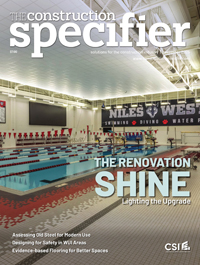The vital importance of specifying
Impacts of a hurried approach
What happens when writers copy specifications from another project? How does it hurt the current project?
Architects and interior designers often have their own unique concept and style behind a certain design. After they develop their design, they give it to the client for approval. Once it has been approved, the architect must deliver the concept design and theme that was agreed upon—in other words, if specifications are inaccurate, the intended design and vision will not be achieved.
When a specification document developed for another project is copied, the specific design intent will differ from the old project to the new project. This can cause inconsistencies and discrepancies between the design intent and final specifications. These differences can cause lots of unnecessary problems during project execution.
For example, stone cladding is available as marble, granite, limestone, and various other materials. In a certain project, the stone cladding might specify slate, and in another it might specify sandstone. If specifications are ‘copied and pasted’ from one project to another, the wrong material’s requirement might be specified.
Not only is design intent a problem when ‘copying and pasting,’ but change orders can also be an issue. Inconsistencies between design and specification will cause the contractor either to downgrade its quality or to ask for more money to cover the unexpected changes. Even if these scenarios are mitigated by using various contractual and legal approaches, change orders are still huge risks that have a negative effect on both designer and developer.
Inadequate performance may also result from improper specifications. Copying from project to project is very risky and will lead to downgrading the ultimate performance of the project. When the specification is written, it is customized for the particular circumstances of the project, and the material performance depends on these circumstances. If writers copy to another project—which has another set of criteria—the performance of the material used will be inaccurate to the circumstances presented for the new project.
For example, curtain wall thermal performance criteria will differ according to climate. If there is a project in a hot, humid area, its thermal performance specification will be different than that of a moderate, dry climate, or a cold, humid one. Copying the specifications in this case, would lead to performance problems in HVAC, thermal comfort, and condensation.
Customizing specifications based on each project and design criteria is crucial for a successful project. Specifications should not be taken lightly and adequate attention should be given to the technical performance of materials. Specifications should be completed by well-versed professionals in full coordination with designers.
Mounir Kronful, BBA, CSI, Assoc. AIA, is the managing director of Construction & Builders, a building material consultancy firm. He has worked as a specification writer in various consultancy firms in the Middle East. Drawing from more than 15 years of experience in specifications and building materials, he leads the way in C&B to provide technical support, specifications and training to architects, engineers, and various professional in the construction sector. He can be reached via e-mail at m.kronful@c-bco.com.








